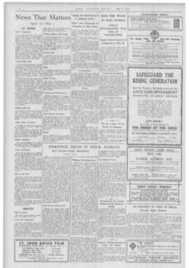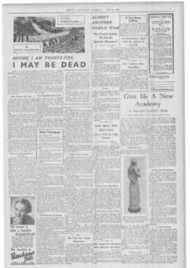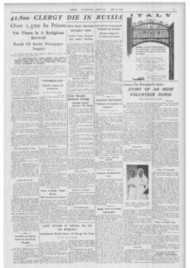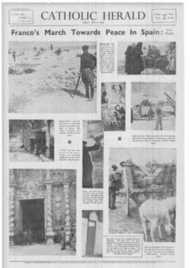Page 15, 6th May 1938
Page 15

Report an error
Noticed an error on this page?If you've noticed an error in this article please click here to report it.
Tags
Share
Related articles
A Roving Causerie
In " Persons And Places "
"his Pen Was Blest"
Of Persons
of Persons And Places
A Roving Causerie
By G. E ANSTRUTHER
Six hundred pilgrims paid homage to the memory of St. Cedd, last year, at the mother-church of Essex at Bradwell-on Sea. This year there is a hope that a still larger number may he attracted to Brad
well. Here, in what was once the Roman purl of (Rhona, St. Chad's brother there is a pitfall for confusion between St. Cedd and St. Ceadda—crected his first Essex church, whence he set out to convert the county. He dedicated that centre to St. Peter, and it is to St. Peter at the Wall that the pilgrims will go next Whit-Monday, making of the holiday a holy day in devotional service.
But these Essex pilgrims have also opportunity to go in the manner, as well as in the spirit, of pilgrims of old. " Bradwell can only be reached by road; no railway station." So Fr. George Steadman, of Burnham-on-Crouch, in whose parish Bradwell is situated, warns the intending. The majority, no doubt, will take the wheel for it so far as that facility allows; but who will be the stalwarts, hard of foot, who will make their pilgrimage also a hike of hikes? Bradwell-on-Sea is eleven miles from Burnham; or, for walkers of somewhat less endurance, eight miles from the station at Southminstcr.
* *
Between the Nationalist outlook for Eire in the terms of the agreement signed last week, and the proposals contained within Gladstonian Home Rule, what an advance! Yet the Home Rule policy came as a thunderbolt to many a British breakfasttable, and split the Liberal Party asunder. On the big night in 1893 when the G.O.M. introduced his second Home Rule Bill, two priests of the Birmingham diocese, Canon Villiers and the Rev. Patrick O'Toole, were among those in the House of Commons. Fr. OThoie afterwards wrote down his impressions of the occasion. It was not perched up in the Strangers' Gallery that the priests heard the debate. By the interest of Mr. Charles Diamond, of the Irish Parliamentary Party, they sat in the little gallery near the Bar, listening to men who had not brevity among their virtues.
Most of the prominent speakers that evening have long since gone from us: Gladstone himself; Sir Edward Clarke; Mr. Sexton, who filled the House as quickly as a predecessor in polemics had nearly emptied it; Colonel Saunderson. the often fiery but greatly enjoyed Protestant champion—these, and others, are with the great majority. But the two clerical listeners from the Midlands happily remain to recall the day.
London's Lord Mayor, with some of the Aldermen, were at Christ Church, in the City, last week, to listen to the Spital Sermon. Betting men may lay any odds they like, and safely, that the average Londoner would come less easily out of the ordeal of being asked to say what is a Spital Sermon, than if the call upon him was for the proper rendering of Phytozoa or Isosceles at one of the now fashionable spelling-bees.
By all rights, the Spital Sermon ought to be preached at Spitaltields; but who, in these times, troubles to associate the name of that district with the spital, or as we should now say, hospital, which Catholic piety built and dedicated to Our Lady in the twelfth century? Walter Brune and his wife Rosia were the founders, and when the Priory of St. Mary of the Spittle was surrendered to the tyrant Tudor at the Dissolution, the hospital belonging to it had a hundred and eighty beds. Long afterwards there remained part of the churchyard, with the pulpit cross from which sermons were preached each year, at Eastertide, until the time of the Great Rebellion. After the Restoration the Spital Sermon was revived, transferred first of all to St. Paul's, then. after the fire of 1666, to St. Bride's, and finally to Christ Church.
* * * *
Catholics who would profit by pulpit exhortations in Spitalfields today have that facility, not merely " at Easter or there
abouts," but throughout the year. The handsome church of St. Anne, served by the Marist Fathers in Underwood Street, is widely known and as widely admired among the faithful of the East End, but most of those living elsewhere have probably never set eyes on a building which well repays the pilgrimage. Designed by Mr. Gilbert Blount, and opened by Cardinal Wiseman on the feast of Our Lady's Nativity in 1855, St. Anne's is by way of being a veteran fabric as our London churches go; but if anything. age has added to its stateliness and dignity.
* * Many besides old Oscotians should be interested in the photograph given in the current Oscotian as its principal illustration—a view of the college chapel of many memories. a building which this month attains its centenary. A survey of the chapel's history during the hundred years would bring into the record noteworthy occasions and would put into the pulpit many a famous preacher; but no day and its preacher can have been more historic for Osoott than the day in 1852 when John Henry Newman preached his famous sermon on the "Second Spring " for the first
Provincial Synod of Westminster. The chapel is associated also with the second and the third Synods.
The restoration recently completed, has made Oscott's chapel rich once more with colour. As a personal contribution to the adornment, the Archbishop of Birmingham, who himself is an Osoott as well as a Cotton man, has presented a new and handsome set of Stations, painted to fit in with , the general colour scheme.
blog comments powered by Disqus

















